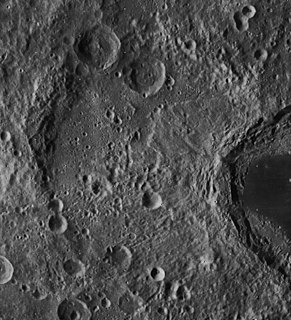
Faraday is a lunar impact crater in the southern highlands of the Moon. It was named after British chemist and physicist Michael Faraday. It lies across the southeast rim of the larger crater Stöfler, and the northwest rim of Faraday forms a wide rampart across the otherwise flat floor of Stöfler. To the east of Faraday is Maurolycus.

Cavalerius is a prominent lunar impact crater that lies on the western edge of the Oceanus Procellarum lunar mare on the west part of the visible Moon. It nearly joins the northern rim of Hevelius to the south.

Byrd is an irregular lunar impact crater that is located near the north pole of the Moon. The north rim of Byrd is nearly connected to the crater Peary, a formation that is adjacent to the pole. The smaller crater Gioja is attached to the remains of the southwest rim.

Blanchinus is a lunar impact crater that is situated in the rugged south-central highlands of the Moon. The crater is named after Italian astronomer Giovanni Bianchini whose Latinized name is Blanchinus. Adjacent to the south of Blanchinus is the crater Werner, and La Caille is attached to the northwest rim. West of the crater is the prominent formation Purbach.

Beals is a lunar impact crater that is located near the eastern limb of the Moon, and lies across the southwestern rim of the crater Riemann. From the Earth the crater is viewed nearly from on edge, and is best seen during favorable librations. To the west is the large walled plain Gauss.

Desargues is an ancient lunar impact crater that is located near the northern limb of the Moon, on the western hemisphere. It lies nearly due south of the crater Pascal, and southeast of Brianchon. The proximity of this crater to the limb means that it appears highly elongated due to foreshortening, and it is difficult to discern details from the Earth.

Buys-Ballot is an oddly-shaped lunar impact crater that is located on the far side of the Moon. It lies just to the northwest of the small lunar mare named Lacus Luxuriae, and southeast of the crater Freundlich. Other nearby craters of note are Anderson to the southwest and Dante to the northeast.

Casatus is a lunar impact crater that is located near the southern limb of the Moon. The north-northeast rim of the crater overlies a portion of the slightly larger crater Klaproth. Along the western rim, Casatus A intrudes somewhat into the interior, producing an inward-bowing rim. To the southeast of Casatus is Newton.

Cleostratus is a lunar impact crater near the northwest limb of the Moon. It lies to the northeast of the crater Xenophanes, and west-southwest of the prominent Pythagoras. From the Earth this crater appears highly elongated due to foreshortening.

Fermi is a large lunar impact crater of the category named a walled plain. It was named after Italian-American physicist and Nobel laureate Enrico Fermi. It lies on the far side of the Moon and can not be viewed from the Earth. Thus this feature must be viewed from an orbiting spacecraft.

Crocco is a lunar impact crater that is located on the far side of the Moon from the Earth. It is located to the northeast of the huge walled plain Planck, and northwest of the equally huge Poincaré. Just to the north, within one crater diameter, is the crater Koch.

Cannizzaro is a lunar impact crater that is located on the Moon's far side as seen from the Earth, just beyond the northwestern limb. It lies in a region of the surface that is sometimes brought into view due to the effects of libration, but not much detail can be seen since this feature is viewed from the side. The crater lies across the southwestern rim of the much larger-walled plain Poczobutt.

Cichus is a lunar impact crater that lies in the southwestern part of the Moon, at the eastern edge of Palus Epidemiarum. Just to the northeast and nearly contacting the rim is the lava-flooded crater remnant Weiss. The crater is named after Italian astronomer Cecco d'Ascoli.

Charlier is a lunar impact crater that is located on the far side of the Moon. To the south-southeast is the larger crater Kovalevskaya, and northeast of Charlier is Perrine.

Wurzelbauer is the remnant of a lunar impact crater. It was named after German astronomer Johann Philipp von Wurzelbauer. It is located in the rugged terrain on the Moon's southern hemisphere. The slightly smaller crater Gauricus lies next to the eastern rim, while to the north-northeast is Pitatus.

Gum is a lunar impact crater that is located near the southeastern limb of the Moon, and is viewed nearly from the side from Earth. It lies along the western edge of the irregular Mare Australe, to the northeast of the crater Hamilton. To the north-northwest is the larger Abel, and to the east-southeast on the far side of the Moon is Jenner.

Douglass is a lunar impact crater on the far side of the Moon. It lies to the southwest of the crater Frost and south-southwest of the large walled plain Landau.

Donner is a lunar impact crater on the far side of the Moon. It is located just to the northeast of the Mare Australe, behind the southeastern limb of the Moon. During favorable librations this part of the lunar surface can be brought into view of the Earth, but the site is viewed from the edge and so not much detail can be seen.

Fersman is a large lunar impact crater on the Moon's far side. It lies to the east of the crater Poynting, and west-northwest of Weyl. To the south is the huge walled plain Hertzsprung.

Poynting is a large lunar impact crater located on the far side of the Moon. It is located to the north-northwest of the walled plain Hertzsprung, with the crater Fersman immediately to the east and Kekulé equally near to the west-southwest.


























